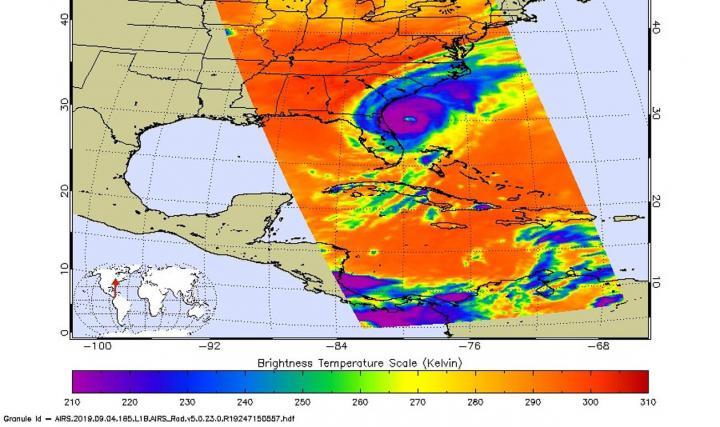
Hurricane Dorian's path forecast shows that it will cross the coast of North Carolina by Friday and move to the southeast of extreme southeastern New England Friday night and approach Nova Scotia later on Saturday.
Though Florida escaped the Dorian storm, it appears now that the Carolinas and even Virginia may suffer the havoc from the restrengthening hurricane Dorian.
As of Thursday morning, September 5, Dorian left coastal South Carolina in heavy waters, an accumulation of over 10 inches off shore along the path of Dorian's inner core. Since Hurricane Dorian is in a forward motion throughout, the recent rainfall totals have remained below the 36-inch accumulation observed in the Bahamas.
As of Friday 2 am EDT, the eye of Hurricane Dorian was located near latitude 34.2 north, longitude 76.8 west, about 30 miles south southwest of Cape Lookout, North Carolina, and 55 miles east of Wilmington, North Carolina.
This time, NASA was able to measure the heavy rainfall unleashed by Dorian hurricane with the help of IMERG. It had left behind over three feet of water in some areas of the Bahamas and is now lashing the Carolinas. NASA also estimated the rainfall rates from the imagery from the Integrated Multi-satEllite Retrievals for GPM or IMERG product at NASA's Goddard Space Flight Center in Greenbelt, Maryland.
The data is calibrated with measurements from the GPM Core Observatory as well as rain gauge networks on the ground and all the measurements are done in near-real time, providing precipitation rate every 30 minutes.

NHC latest bulletin:
NHC's latest bulletin at 8 a.m. EDT (1200 UTC), Thursday noted the eye of Hurricane Dorian was located near latitude 32.1 degrees North, longitude 79.3 degrees West, at about 70 miles (115 km) south-southeast of Charleston, South Carolina.

Dorian is now moving toward the north-northeast and has been categorized a 3 hurricane on the Saffir-Simpson Hurricane Wind Scale. It may dilute by Friday morning, followed by slow weakening through Saturday, said NHC. However, Dorian is expected to remain a hurricane for the next few days. Its force winds extend outward up to 60 miles (95 km) from the center, and tropical-storm-force winds extend outward up to 195 miles (315 km).
Charleston International Airport recently received a wind gust of 61 mph (98 kph) and the estimated minimum central pressure based on Air Force Reserve Hurricane Hunter data is 959 millibars.









